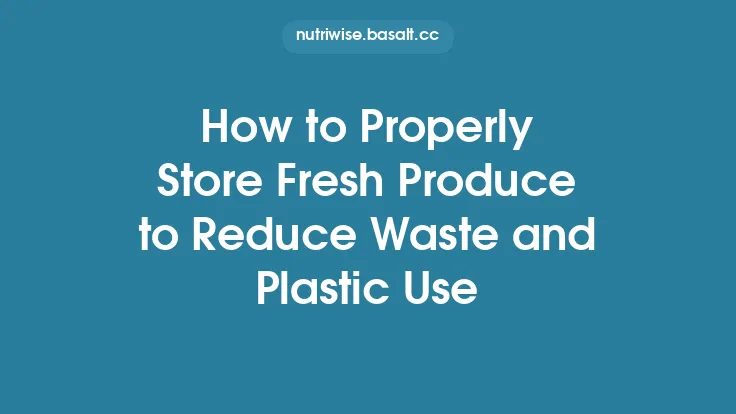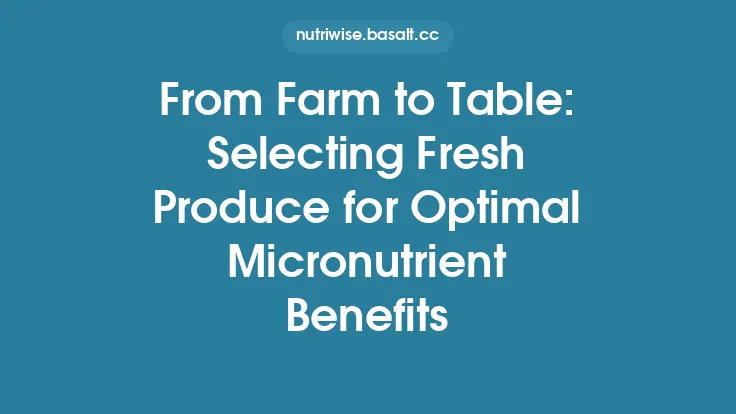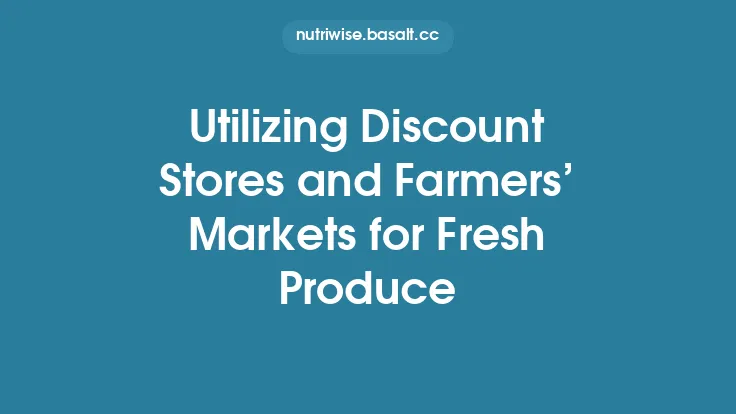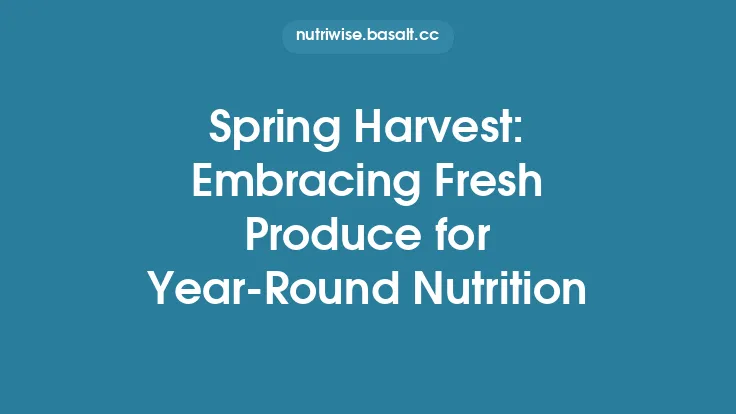Fresh produce is the cornerstone of a healthy, vibrant diet, yet it is also one of the most perishable food groups in the kitchen. Even when you buy the best‑quality fruits and vegetables, a lack of proper storage can turn a nutritious purchase into waste within days. Understanding the science behind how different produce items deteriorate—and applying targeted storage strategies—can dramatically extend their shelf life, preserve flavor and nutrients, and reduce the amount of food that ends up in the trash. Below is a comprehensive guide that walks you through the fundamentals of produce preservation, the role of temperature, humidity, and ethylene, and practical, low‑cost methods you can implement in any home kitchen.
The Science of Produce Spoilage
Cellular Structure and Water Loss
Fruits and vegetables are living tissues composed of cells that contain water, sugars, acids, and enzymes. After harvest, metabolic processes continue at a reduced rate. Water loss through transpiration causes wilting, while enzymatic activity can break down cell walls, leading to soft spots and decay. The rate of these processes is heavily influenced by temperature and relative humidity.
Respiration and Ethylene Production
Most produce continues to respire—taking in oxygen and releasing carbon dioxide—after being picked. Some items, such as apples, bananas, tomatoes, and avocados, also emit ethylene, a plant hormone that accelerates ripening in both the producing fruit and nearby ethylene‑sensitive produce (e.g., leafy greens, carrots, and berries). Managing ethylene exposure is therefore a key component of extending shelf life.
Microbial Growth
Bacteria, yeasts, and molds thrive in moist, warm environments. Surface injuries, bruises, or compromised skins provide entry points for microbes, which can quickly proliferate and cause spoilage. Proper handling and storage conditions that limit moisture accumulation on the surface can curb microbial growth.
Temperature: The Primary Preservation Lever
Refrigeration Zones and Their Impact
- Cold‑Store (0 °C–4 °C / 32 °F–39 °F): Ideal for most leafy greens, cruciferous vegetables (broccoli, cauliflower), carrots, and root crops. The low temperature slows respiration and enzymatic activity without causing freezing injury.
- Cool‑Store (5 °C–10 °C / 41 °F–50 °F): Suited for fruits that are sensitive to chilling injury, such as tomatoes, avocados, peaches, and citrus. These items benefit from a modest chill that delays ripening but does not damage cell membranes.
- Room Temperature (15 °C–22 °C / 59 °F–72 °F): Best for ethylene‑producing fruits that need to finish ripening (bananas, mangoes, papayas). Keeping them at ambient temperature allows controlled ripening before they are moved to cooler storage.
Avoiding Chilling Injury
Certain produce, especially tropical fruits (e.g., mangoes, pineapples) and some vegetables (e.g., cucumbers, eggplants), develop pitting, discoloration, or off‑flavors when stored below their optimal temperature range. The rule of thumb: if a fruit or vegetable feels “cold” to the touch when you buy it, it likely should not be placed directly in the refrigerator until it is fully ripe.
Practical Tips for Temperature Management
- Use a Dedicated Produce Drawer: Most refrigerators have a crisper drawer with adjustable humidity settings. Set it to low humidity for ethylene‑producing fruits and high humidity for leafy greens.
- Monitor Fridge Temperature: A simple fridge thermometer ensures you stay within the 0 °C–4 °C range for most vegetables. Adjust the thermostat if you notice frequent temperature spikes.
- Stagger Ripening: Keep a small batch of ethylene‑producing fruit on the counter to ripen, then transfer the ripe portion to the fridge to halt further ripening.
Humidity Control: Keeping Moisture in Check
High vs. Low Humidity Environments
- High Humidity (≈85%–95%): Prevents water loss in leafy greens, herbs, and vegetables with high transpiration rates (e.g., lettuce, spinach, kale). It reduces wilting but can encourage mold if excess moisture accumulates.
- Low Humidity (≈45%–55%): Ideal for fruits that are prone to rot when moisture sits on their skins (e.g., berries, grapes, mushrooms). It encourages a dry surface, limiting fungal growth.
Implementing Humidity Controls at Home
- Crisper Drawer Settings: Most drawers have a slider or vent that lets you choose high or low humidity. Use the high‑humidity setting for vegetables and the low‑humidity setting for fruits.
- Paper Towels and Perforated Bags: Line the drawer with a damp (not wet) paper towel for high humidity, or place produce in perforated plastic bags to allow excess moisture to escape while retaining enough ambient humidity.
- Reusable Produce Bags: Mesh or breathable fabric bags (e.g., cotton produce bags) provide a middle ground, allowing airflow while reducing rapid dehydration.
Ethylene Management: The Invisible Ripening Agent
Identifying Ethylene Producers and Sensitive Items
| Ethylene Producers | Ethylene Sensitive |
|---|---|
| Apples, bananas, avocados, kiwis, mangoes, papayas, pears, tomatoes | Leafy greens (lettuce, spinach, kale), carrots, broccoli, cucumbers, potatoes, berries, onions |
Strategies to Minimize Unwanted Ripening
- Separate Storage: Keep ethylene producers in a distinct drawer or on a separate shelf from sensitive vegetables. If space is limited, use a small airtight container for the ethylene‑producing items.
- Use Ethylene‑Absorbing Products: Commercial ethylene filters (often based on potassium permanganate) can be placed in the fridge to capture gas. Alternatively, a small bowl of activated charcoal can serve a similar function.
- Natural Absorbers: A few slices of fresh ginger or a piece of unscented charcoal placed near ethylene‑sensitive produce can modestly reduce gas concentration.
- Rotate Stock: Practice “first‑in, first‑out” (FIFO) to ensure older produce is used before newer items, reducing the time ethylene has to act on stored vegetables.
Packaging Solutions: Balancing Airflow and Moisture
The Role of Permeable vs. Impermeable Materials
- Permeable Materials (e.g., perforated plastic, mesh bags, paper): Allow excess moisture to escape, reducing the risk of mold on high‑moisture fruits.
- Impermeable Materials (e.g., sealed plastic bags, airtight containers): Retain humidity, which is beneficial for leafy greens but can cause condensation and rot if not monitored.
Best‑Practice Packaging for Common Produce
| Produce | Recommended Packaging | Reason |
|---|---|---|
| Berries (strawberries, blueberries) | Original vented clamshell or a shallow container lined with paper towels, loosely covered with a breathable lid | Low humidity, airflow prevents mold |
| Leafy Greens (lettuce, kale) | Perforated bag or container with a damp paper towel | High humidity maintains crispness |
| Carrots & Celery | Airtight container with a small amount of water (just enough to keep them moist) | Prevents dehydration while limiting bacterial growth |
| Mushrooms | Paper bag (no plastic) | Absorbs excess moisture, prevents sogginess |
| Tomatoes | Cardboard box or breathable produce bag at room temperature, then fridge once fully ripe | Allows ethylene to dissipate, prevents chilling injury |
| Apples | Plastic bag with a few holes, stored in fridge crisper | Controls humidity while allowing ethylene to escape slowly |
DIY Storage Hacks
- The “Two‑Bucket” System: One bucket lined with a dry towel for high‑humidity vegetables, another with a paper towel for low‑humidity fruits. This visual separation makes it easy to remember which produce belongs where.
- Reusable Silicone Lids: For cut produce (e.g., sliced cucumbers, bell peppers), silicone lids create a semi‑airtight seal that limits oxidation while still allowing a small amount of gas exchange.
Pre‑Storage Preparation: Handling Produce to Extend Life
Cleaning vs. Washing
- Wash Only When Ready to Use: Moisture is a primary driver of microbial growth. For most produce, especially berries, mushrooms, and leafy greens, it is best to keep them dry until just before consumption.
- Dry Thoroughly If Washing Early: If you must wash ahead of time (e.g., for convenience), spin the produce in a salad spinner and pat dry with a clean towel. Store in a breathable container to avoid trapped moisture.
Trimming and Removing Damaged Parts
- Inspect Immediately: Cut away bruised or soft spots with a clean knife. Even a small damaged area can become a hotspot for bacterial proliferation.
- Separate Ethylene‑Sensitive Items: If a fruit shows signs of ripening (e.g., a banana turning yellow), move it to a separate compartment to prevent it from affecting nearby vegetables.
Portioning for Longevity
- Divide Large Batches: For items like carrots or celery, cut them into sticks and store in individual portions. This reduces the number of times the container is opened, limiting exposure to air and humidity fluctuations.
- Use Vacuum‑Sealed Bags for Long‑Term Storage: While not suitable for all produce, vacuum sealing can dramatically extend the life of items like potatoes, onions, and certain root vegetables when combined with a cool, dark environment.
Environmental Considerations: Sustainable Storage Practices
Energy‑Efficient Refrigeration
- Keep the Fridge Full, Not Overcrowded: A well‑stocked fridge retains cold better than an empty one, reducing compressor cycles and energy use.
- Avoid Door Storage for Sensitive Produce: The temperature in the fridge door fluctuates more than in the main compartment, which can accelerate spoilage for delicate items.
Reducing Plastic Waste
- Opt for Reusable Produce Bags: Cotton, linen, or mesh bags replace single‑use plastic and still provide the necessary breathability.
- Glass Containers with Lids: For cut produce, glass containers are durable, recyclable, and do not leach chemicals.
Extending Shelf Life Without Additives
- Natural Antimicrobials: A light mist of diluted lemon juice (1 % citric acid) can inhibit bacterial growth on cut apples and avocados, preserving color and texture without synthetic preservatives.
- Cold Water Soak for Certain Vegetables: A brief (5‑minute) soak in cold water followed by thorough drying can revive wilted lettuce or spinach, restoring turgor pressure and extending usability.
Seasonal Adjustments: Tailoring Storage to the Time of Year
Summer Heat
- Increase Humidity for Greens: In hot, dry climates, leafy greens lose moisture quickly. Use a damp cloth or a small water reservoir in the crisper drawer to maintain a higher relative humidity.
- Prioritize Quick‑Use Produce: Summer yields many perishable items (e.g., berries, tomatoes). Plan to consume them within a few days or freeze portions for later use.
Winter Cold
- Guard Against Freezing Damage: Store root vegetables (potatoes, carrots) in a cool, dark pantry rather than the fridge to avoid frostbite.
- Utilize the Fridge’s “Freezer” Compartment: Some refrigerators have a small “freezer‑lite” area that can keep ethylene‑producing fruits at a slightly cooler temperature without freezing, slowing ripening during winter months.
Troubleshooting Common Storage Problems
| Symptom | Likely Cause | Remedy |
|---|---|---|
| Leafy greens become slimy within 2 days | Excess moisture + low airflow | Transfer to a perforated bag, add a dry paper towel, and ensure the crisper is set to high humidity but not sealed |
| Berries develop mold quickly | High humidity + sealed container | Store in original vented container or a shallow bowl with a paper towel, keep in the fridge’s low‑humidity drawer |
| Apples turn brown after a week | Ethylene exposure + oxidation | Keep apples in a sealed bag with a few holes, add a slice of lemon or a small piece of activated charcoal to absorb ethylene |
| Carrots become rubbery | Low humidity + dehydration | Store in an airtight container with a small amount of water (just enough to keep the environment moist) |
| Tomatoes become mealy after refrigeration | Chilling injury | Keep tomatoes at room temperature until fully ripe; if already soft, use them in cooked dishes rather than fresh salads |
Putting It All Together: A Step‑by‑Step Storage Routine
- Sort Immediately After Shopping
- Separate ethylene producers from ethylene‑sensitive items.
- Identify produce that needs to ripen at room temperature.
- Inspect and Trim
- Remove any bruised or damaged portions.
- For leafy greens, trim the stems and discard wilted leaves.
- Choose the Right Container
- Use breathable bags for berries and mushrooms.
- Place leafy greens in perforated bags with a damp paper towel.
- Store carrots, celery, and similar vegetables in airtight containers with a splash of water.
- Set Crisper Drawers
- High humidity for vegetables (leafy greens, carrots).
- Low humidity for fruits (berries, grapes).
- Monitor Temperature
- Keep the fridge at 0 °C–4 °C.
- Use a fridge thermometer and adjust as needed.
- Implement Ethylene Controls
- Store ethylene producers in a separate drawer or container.
- Add an ethylene‑absorbing filter if you have many ethylene‑sensitive items.
- Rotate Stock Weekly
- Check the oldest items first and move them to the front of the drawer.
- Use a simple “date‑stamped” label system if you store large quantities.
- Re‑evaluate Weekly
- Remove any produce that shows signs of spoilage to prevent cross‑contamination.
- Adjust humidity settings based on observed performance (e.g., add or remove paper towels).
Conclusion
Storing fresh produce for maximum longevity is a blend of science, observation, and simple household practices. By mastering temperature zones, humidity control, ethylene management, and appropriate packaging, you can keep fruits and vegetables crisp, flavorful, and nutritionally robust for far longer than the average shopper expects. The payoff is twofold: you enjoy fresher meals while dramatically cutting the amount of food that ends up in the landfill—a win for your wallet, your health, and the planet. Implement these strategies today, and watch your kitchen waste shrink as your produce stays vibrant and ready to nourish.





